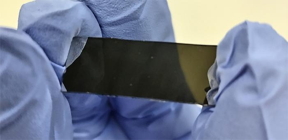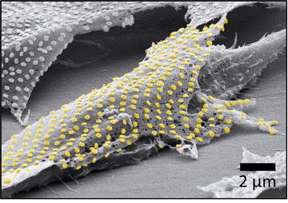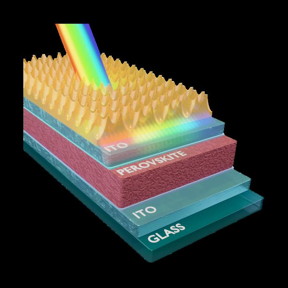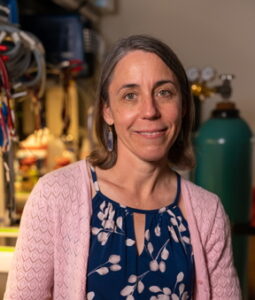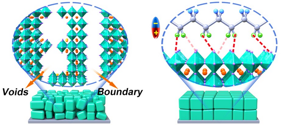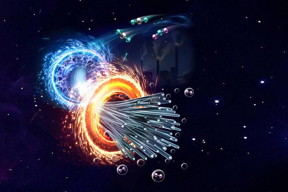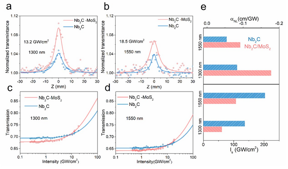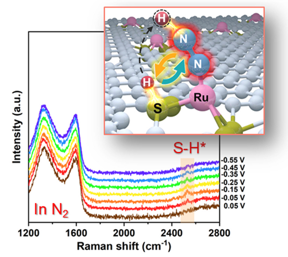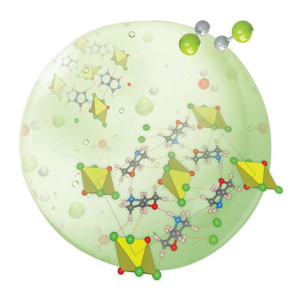Home > Press > Channeling mechanical energy in a preferred direction
Abstract:
A research group led by scientists from the RIKEN Center for Emergent Matter Science have developed a unique material, based on nanofillers embedded in a hydrogel, that can channel mechanical energy in one direction but not the other, acting in a “nonreciprocal” way. With this composite material--which can be constructed at various sizes--the team was able to use vibrational up-and-down movements to make liquid droplets rise within a material against gravity. Using this material could thus make it possible to make use of random vibrations and move matter in a preferred direction.
Channeling mechanical energy in a preferred direction
Saitama, Japan | Posted on April 14th, 2023Channeling energy in a preferred direction is an important property that actually makes life possible. Many basic biological functions such as photosynthesis and cellular respiration are made possible by channeling random fluctuations in nature in a nonreciprocal way, to drive a system away from increasing entropy, like the famed Maxwell’s demon. For example, devices that allow energy to move preferentially are in electronics, where they allow AC current to be transformed into DC current. Similar devices are used in the fields of photonics, magnetism, and sound. However, despite the many potential uses, creating devices that channel mechanical energy has proven to be more difficult.
Now, a RIKEN-led group has developed a remarkable but uniform material that is relatively easy to produce and can perform this function. To create it, the group used a hydrogel--a soft material made mainly of water and a polyacrylamide network--and embedded graphene oxide nanofillers into it at a tilted angle. The hydrogel is fixed to the floor, so that the top part can move when subjected to a shear force but not the bottom. And the fillers are set at a tilted angle, so that they angle clockwise from top to bottom. When a shear force is applied from right to left into the leaning nanofillers, they tend to buckle and hence lose their resistance. But if the force is from the other direction, and the nanofillers are facing away from it, the applied shear merely makes them stretch even longer, and they maintain their strength. This allows the sheet to deform in one direction but not the other, and in fact the group measured this difference, finding that the material was approximately 60 times as resistant in one direction than the other.
As an experiment to demonstrate what this could actually do, they created a block of the material and placed it on a vibrating stand. Depending on the tilt direction of the embedded nanofillers, the material was able to channel the vibrational energy through the material to make droplets move to the right or left. They could also use the vibrations to drive a circular motion that could be controlled to be either clockwise or anticlockwise. When setting up the vibrating stand vertically, drops of colored liquid that were placed on the hydrogel moved upward against gravity as if by magic. In this way, alternating vibrational movements, which are usually not of any use, were channeled to create net motion.
Finally, as a further test, in collaboration with researchers from the RIKEN Hakubi Fellows program, the group placed Caenorhabditis elegans worms on the material, and although their movements are normally random, they ended up all moving to one side or the another of the hydrogel, depending on the tilt direction of the embedded nanofillers.
According to Yasuhiro Ishida of the RIKEN Center for Emergent Matter Science who led the project, “It was a remarkable and surprising result, seeing how mechanical energy could be channeled in one direction preferentially, in such a clear way, and using a material that is rather easy to make and quite scalable. In the future, we plan to find applications for this material, with the hope that we can use it to make effective use of vibrational energy that, up until now, has been seen as waste.”
####
For more information, please click here
Contacts:
Jens Wilkinson
RIKEN
Office: 81-484-621-424
Issuers of news releases, not 7th Wave, Inc. or Nanotechnology Now, are solely responsible for the accuracy of the content.
| Related Links |
| Related News Press |
News and information
![]() New family of wheel-like metallic clusters exhibit unique properties April 14th, 2023
New family of wheel-like metallic clusters exhibit unique properties April 14th, 2023
![]() Efficient heat dissipation perovskite lasers using a high-thermal-conductivity diamond substrate April 14th, 2023
Efficient heat dissipation perovskite lasers using a high-thermal-conductivity diamond substrate April 14th, 2023
![]() Nanobiotechnology: How Nanomaterials Can Solve Biological and Medical Problems April 14th, 2023
Nanobiotechnology: How Nanomaterials Can Solve Biological and Medical Problems April 14th, 2023
![]() New Developments in Biosensor Technology: From Nanomaterials to Cancer Detection April 14th, 2023
New Developments in Biosensor Technology: From Nanomaterials to Cancer Detection April 14th, 2023
Possible Futures
![]() New family of wheel-like metallic clusters exhibit unique properties April 14th, 2023
New family of wheel-like metallic clusters exhibit unique properties April 14th, 2023
![]() Diamond cut precision: University of Illinois to develop diamond sensors for neutron experiment and quantum information science April 14th, 2023
Diamond cut precision: University of Illinois to develop diamond sensors for neutron experiment and quantum information science April 14th, 2023
![]() Implantable device shrinks pancreatic tumors: Taming pancreatic cancer with intratumoral immunotherapy April 14th, 2023
Implantable device shrinks pancreatic tumors: Taming pancreatic cancer with intratumoral immunotherapy April 14th, 2023
Discoveries
![]() Efficient heat dissipation perovskite lasers using a high-thermal-conductivity diamond substrate April 14th, 2023
Efficient heat dissipation perovskite lasers using a high-thermal-conductivity diamond substrate April 14th, 2023
![]() Data can now be processed at the speed of light! April 14th, 2023
Data can now be processed at the speed of light! April 14th, 2023
![]() Diamond cut precision: University of Illinois to develop diamond sensors for neutron experiment and quantum information science April 14th, 2023
Diamond cut precision: University of Illinois to develop diamond sensors for neutron experiment and quantum information science April 14th, 2023
![]() Implantable device shrinks pancreatic tumors: Taming pancreatic cancer with intratumoral immunotherapy April 14th, 2023
Implantable device shrinks pancreatic tumors: Taming pancreatic cancer with intratumoral immunotherapy April 14th, 2023
Announcements
![]() Nanobiotechnology: How Nanomaterials Can Solve Biological and Medical Problems April 14th, 2023
Nanobiotechnology: How Nanomaterials Can Solve Biological and Medical Problems April 14th, 2023
![]() New Developments in Biosensor Technology: From Nanomaterials to Cancer Detection April 14th, 2023
New Developments in Biosensor Technology: From Nanomaterials to Cancer Detection April 14th, 2023
![]() IOP Publishing celebrates World Quantum Day with the announcement of a special quantum collection and the winners of two prestigious quantum awards April 14th, 2023
IOP Publishing celebrates World Quantum Day with the announcement of a special quantum collection and the winners of two prestigious quantum awards April 14th, 2023
![]() Data can now be processed at the speed of light! April 14th, 2023
Data can now be processed at the speed of light! April 14th, 2023
Interviews/Book Reviews/Essays/Reports/Podcasts/Journals/White papers/Posters
![]() New family of wheel-like metallic clusters exhibit unique properties April 14th, 2023
New family of wheel-like metallic clusters exhibit unique properties April 14th, 2023
![]() Efficient heat dissipation perovskite lasers using a high-thermal-conductivity diamond substrate April 14th, 2023
Efficient heat dissipation perovskite lasers using a high-thermal-conductivity diamond substrate April 14th, 2023
![]() Diamond cut precision: University of Illinois to develop diamond sensors for neutron experiment and quantum information science April 14th, 2023
Diamond cut precision: University of Illinois to develop diamond sensors for neutron experiment and quantum information science April 14th, 2023
![]() Implantable device shrinks pancreatic tumors: Taming pancreatic cancer with intratumoral immunotherapy April 14th, 2023
Implantable device shrinks pancreatic tumors: Taming pancreatic cancer with intratumoral immunotherapy April 14th, 2023
Energy
![]() A universal HCl-assistant powder-to-powder strategy for preparing lead-free perovskites March 24th, 2023
A universal HCl-assistant powder-to-powder strategy for preparing lead-free perovskites March 24th, 2023
![]() Make them thin enough, and antiferroelectric materials become ferroelectric February 10th, 2023
Make them thin enough, and antiferroelectric materials become ferroelectric February 10th, 2023
Battery Technology/Capacitors/Generators/Piezoelectrics/Thermoelectrics/Energy storage
![]() Bilayer PET/PVDF substrate-reinforced solid polymer electrolyte improves solid-state lithium metal battery performance March 24th, 2023
Bilayer PET/PVDF substrate-reinforced solid polymer electrolyte improves solid-state lithium metal battery performance March 24th, 2023
![]() Novel microscope developed to design better high-performance batteries: Innovation gives researchers inside view of how batteries work February 10th, 2023
Novel microscope developed to design better high-performance batteries: Innovation gives researchers inside view of how batteries work February 10th, 2023
![]() Make them thin enough, and antiferroelectric materials become ferroelectric February 10th, 2023
Make them thin enough, and antiferroelectric materials become ferroelectric February 10th, 2023
- SEO Powered Content & PR Distribution. Get Amplified Today.
- Platoblockchain. Web3 Metaverse Intelligence. Knowledge Amplified. Access Here.
- Minting the Future w Adryenn Ashley. Access Here.
- Source: http://www.nanotech-now.com/news.cgi?story_id=57327
- :has
- :is
- $UP
- 10
- 27th
- a
- Able
- AC
- accuracy
- Achieve
- actually
- against
- All
- allows
- Although
- and
- Announcement
- Another
- any
- applications
- applied
- approach
- approximately
- April
- ARE
- AS
- At
- based
- basic
- batteries
- battery
- BE
- become
- been
- Better
- Block
- boston
- Bottom
- by
- CAN
- Cancer
- carbon
- celebrates
- Center
- CGI
- challenges
- Channel
- clear
- click
- collaboration
- collection
- COM
- comment
- commercialisation
- content
- controlled
- Conversion
- could
- create
- created
- Creating
- Current
- Cut
- day
- dc
- deal
- demonstrate
- Depending
- Design
- Despite
- develop
- developed
- developing
- developments
- develops
- device
- Devices
- Diamond
- difference
- difficult
- direction
- discover
- drive
- Drops
- Effective
- either
- Electronics
- embedded
- energy
- enough
- Ether (ETH)
- Even
- example
- exhibit
- experiment
- facing
- family
- February
- Fields
- films
- Find
- finding
- fixed
- flexible
- Floor
- flow
- fluctuations
- For
- Force
- from
- function
- functions
- further
- future
- gif
- gives
- Global
- Graphene
- gravity
- Group
- Have
- help
- High
- high-performance
- hope
- How
- However
- http
- HTTPS
- illinois
- image
- important
- improves
- in
- Inc.
- Including
- increasing
- inexpensive
- information
- Innovation
- IT
- January
- Japan
- landmark
- lasers
- Led
- Life
- like
- links
- Liquid
- lithium
- longer
- lose
- made
- magic
- Magnetism
- maintain
- make
- MAKES
- many
- March
- material
- materials
- Matter
- mechanical
- medical
- merely
- metal
- method
- Microscope
- more
- motion
- move
- movements
- moving
- Nanomaterials
- nanotechnology
- Nature
- net
- New
- news
- normally
- of
- on
- ONE
- optimal
- Origin
- Other
- part
- perform
- Photosynthesis
- PHP
- plan
- plastic
- plato
- Plato Data Intelligence
- PlatoData
- please
- polymer
- possible
- Post
- posted
- potential
- Precision
- preferred
- preparing
- prestigious
- produce
- Program
- project
- promising
- property
- propose
- proposed
- proven
- Publishing
- Quantum
- quantum information
- random
- rather
- relatively
- Releases
- remarkable
- research
- research group
- researchers
- Resistance
- resistant
- responsible
- result
- return
- RIKEN
- Rise
- Save
- scalable
- Science
- scientists
- Search
- secondary
- seeing
- sensors
- set
- setting
- Share
- Signs
- similar
- Simple
- So
- Soft
- solid
- SOLVE
- Sound
- special
- speed
- stand
- start
- storage
- Strategy
- strength
- submit
- such
- suitable
- surprising
- Sustainability
- system
- team
- Technology
- test
- that
- The
- The Future
- their
- Them
- Through
- times
- to
- top
- transformed
- understand
- unique
- Universal
- university
- upward
- us
- use
- used
- usually
- various
- vertically
- View
- Waste
- Water
- Wave
- Way..
- What
- which
- WHO
- winners
- with
- within
- world
- worms
- Yahoo
- zephyrnet










